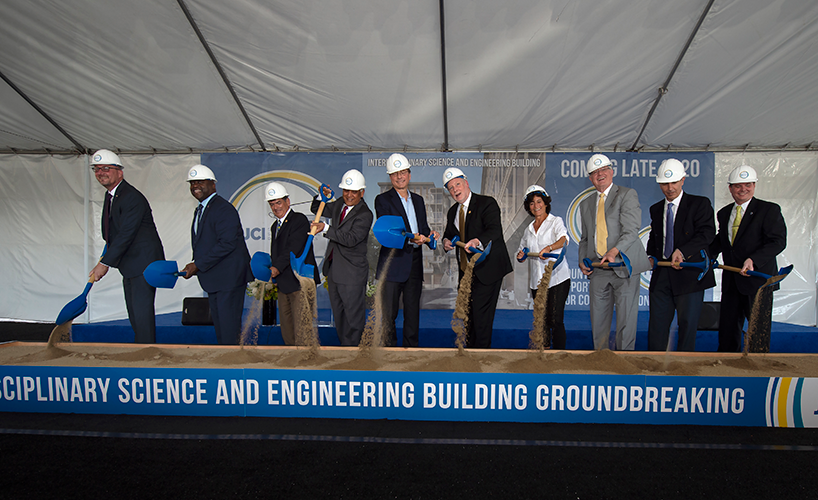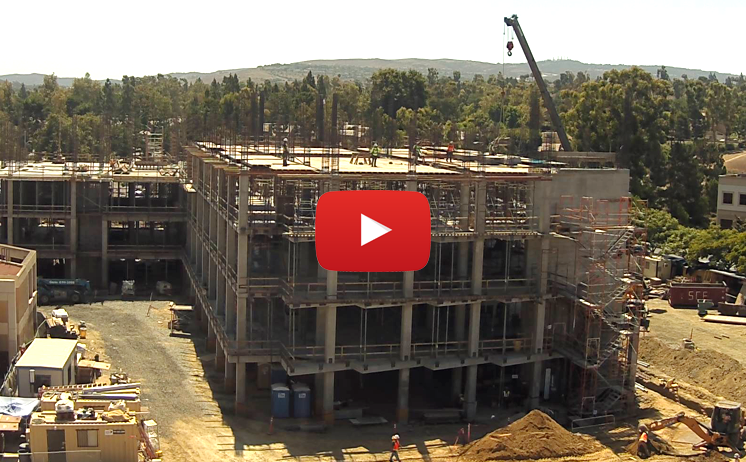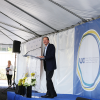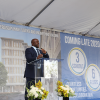Interdisciplinary Science and Engineering Building Breaks Ground

July 25, 2018 - Construction on UC Irvine’s newest multidisciplinary research building is officially underway this month after a July 16 groundbreaking ceremony that was attended by nearly 200 faculty, staff, corporate partners and community members.
The Interdisciplinary Science and Engineering Building – the result of a unique funding collaboration among the campus, state and private donors – will comprise more than 200,000 square feet of research, office and meeting space. When completed in late 2020, it will house faculty, staff and students from the schools of engineering, physical sciences, and computer science and engineering, who will collaborate on a wide range of scientific challenges. A host of speakers at the groundbreaking event alluded to the building’s certain impact on the future of research.
Event emcee Pramod Khargonekar, vice chancellor for research, told the crowd, seated at the building site under a large white tent, that the ISEB will enable convergence research – interdisciplinary inquiry that will converge on large societal problems including biomedicine for health and energy/environment. “This holds enormous promise for the future,” Khargonekar said.
Samueli School Dean Gregory Washington drew sustained audience laughter when he said, “I guarantee you this building will be a greater benefit than the parking spaces we’re losing,” a reference to the faculty/staff parking lot that will now become the site of the structure. Striking a more serious note, he told the crowd that the new building will have substantial impact on three major areas for the engineering school. It will provide much-needed space for researchers to solve societal problems and engage in important partnerships, and support the hiring of more faculty.
Smart-grid technologies, transportation systems, energy storage, renewable energy technology, greenhouse-gas-reduction approaches and zero-carbon mobility systems are among the research endeavors that will occupy the new space. “This facility will enable our faculty to engage companies in interdisciplinary research unlike any facility on campus,” Washington added.
He said the school’s biggest challenge is “we don’t have enough faculty and we can’t educate enough students and provide opportunity for all students who want to come here.” The Samueli School received more than 14, 400 engineering applications this year for a mere 950 slots. “This building will enable us to grow substantially and that growth will allow us to accommodate and engage more students,” Washington said. “This is, in the end, what it’s all about.”
Physical Sciences Dean Ken Janda said the ISEB will “reduce the barriers between discovery of new knowledge and the implementation of that knowledge. … The beauty of this new facility is that it will bring scientists, mathematicians, engineers and computer scientists into close proximity to reduce the barriers to discovery and the time needed to solve problems.”
Janda was followed at the podium by Marios Papaefthymiou, dean of the Bren School of Information and Computer Sciences, who spoke of computing’s role in the transformation of our daily lives. “Computer science plays a central role [in this transformation] and through this new building we will be able to physically be in the center of all this activity, surrounded by engineers, physical scientists, chemists, physicists, mathematicians … I look forward to all of the research activities that will be happening in this new building,” he told the audience.
Campus architect Brian Pratt remarked that the building, which is on track to garner a Platinum LEED rating for sustainability, was designed to reflect the university’s vision of the future of research. Six floors of wet labs, dry labs, classrooms, collaborative hubs, faculty offices, food service and outdoor interactive spaces “incorporate the most current thinking in laboratory design with unique opportunities for deep collaboration.
“We look forward to this new building’s contribution to the enhancement of the fabric and culture of the campus, and we are excited to see it developed as a research and social hub of activity and most importantly, we eagerly anticipate its enormous impact on UCI’s research accomplishments,” Pratt said.
UCI Chancellor Howard Gillman has long advocated for a campus building devoted to the convergence of science and engineering. “As with all ambitious visions,” he said, “it wasn’t obvious how we would secure the resources necessary to turn this very ambitious vision into a reality.”
Gillman credited Meredith Michaels, now retired campus budget director and chief financial officer, for bringing to his attention a onetime funding opportunity offered by the state. California would contribute $50 million in state funds for a new building if UCI contributed $40 million and secured a private donation as well.
Long-time donor Henry Samueli and his wife, Susan, became the building’s benefactors. The Samueli Foundation made a transformative $30 million gift, and the dream became a reality.
“Henry and Susan are very smart people and it didn’t take long for them to understand this was a tremendous opportunity,” Gillman said. “It’s because of their inspirational support of this building that our faculty, students and staff are going to be able to tackle big questions across disciplinary boundaries, and we really have increased the impact of the campus in the world, in a way that anyone who believes in the research mission of higher education knows is so important.”
Samueli, Broadcom co-founder, chief technical officer and former chairman of the board, has been closely connected to the University of California for many years as a student, faculty member and donor. “As the chancellor said, it was a pretty unique opportunity,” Samueli said at the ceremony, “and I recognized very quickly how unique and rare it was. If Susan and I could step in and make this gift, the building was virtually funded.”
He added that his return on investment, while not providing personal benefit, “comes to our personal passions, which, for me, is just as good.”
The Samuelis have made several important gifts to UCI, including naming gifts to the engineering school and the College of Health Sciences. “Susan and I are already multidisciplinary donors to the university through my passion in engineering and her passions in the health sciences, so we we’re already trying to stir the pot to do interdisciplinary work,” he said. “When you add in all the other grand challenges, this really does present a great opportunity for collaborative research.
“UCI can really take a leadership role in many of these areas because of what this building can do.”
- Anna Lynn Spitzer



